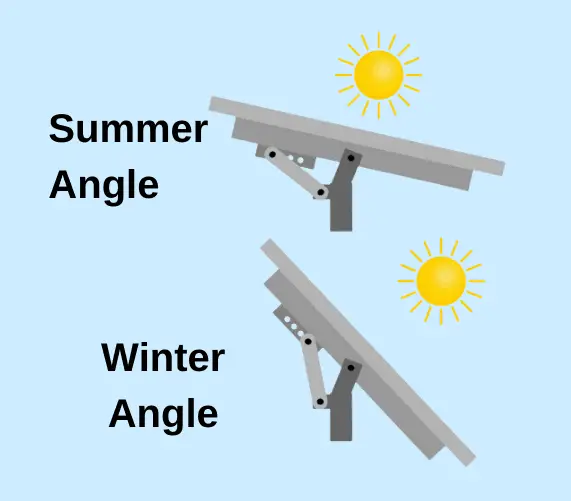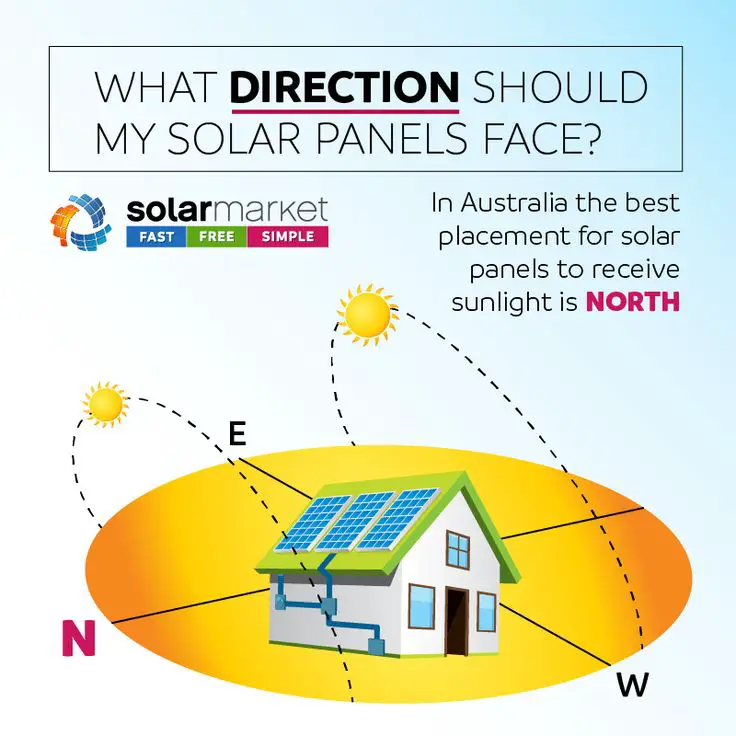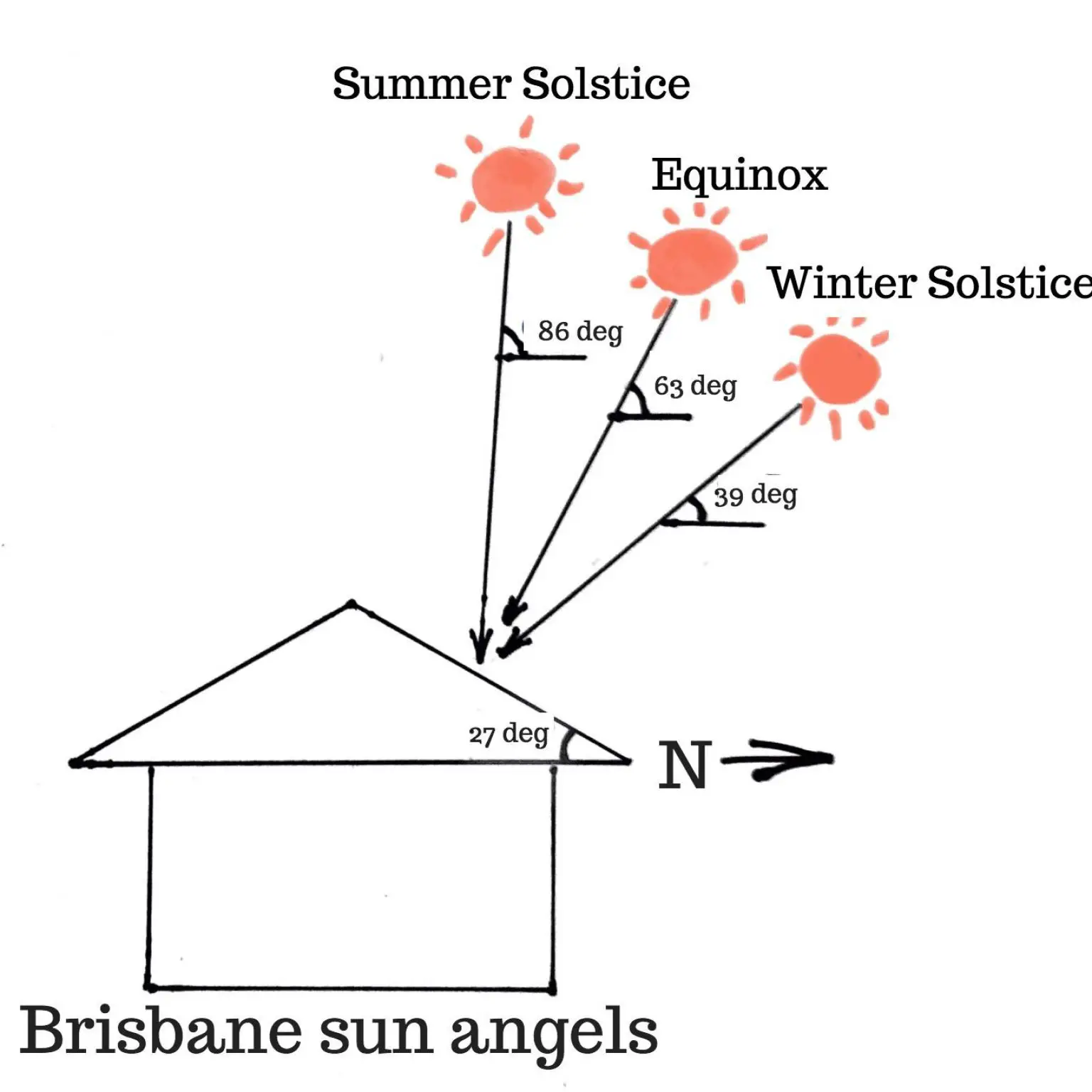What Is The Best Direction To Face Solar Panels In Australia
North-facing panels will usually give the greatest energy output. Thatâs because Australia, being in the southern hemisphere, experiences a sun that is mostly directed from the north. But did you know that facing west will only reduce your solar systemâs total annual energy output by about 15 per cent . And this might just be a smart decision.
As you can see from the above graph, North at 30â tilt is optimal for Sydney to generate the maximum amount of energy over the whole year.
But for many households, maximum solar energy production does not always equate to optimal power saving the most money off your electricity bills.
Firstly you need to know if you are on a flat electricity tariff – you pay the same rate for your electricity regardless of the time of day – or if your rate varies. Electricity networks such as AusGrid, CitiPower, Ergon are encouraging variable or time-of-use pricing.
Ausgrid peak demand times
The major cost in electricity bills , is in fact the poles and wires, which need to be sized to meet peak demand. Hence the push to charge more for electricity consumed at times of peak demand.
Mount solar panels to catch the sunlight from the west in the afternoon, and the panelsâ production overall energy production would drop, but it would come at hours when the electricity was is often more valuable during these peak demand periods .
How do you know what solar system will be right for your home?
Recent Study Reveals Some Interesting Facts
The conventional understanding is that the solar panel facing south will receive the most sunlight. This is correct to a certain extent however recent studies have proven differently: According to a new study from Pecan Street Research Institute, West-facing rooftop solar panels produced 49 percent more electricity during peak demand compared to south-facing panels . This research was conducted and data was collected from fifty homes in Austin, Texas, which had solar panels installed in different directions. Some homes had only south facing panels, some only west facing panels while some had both.
Solar panel direction Northern and Southern Hemisphere
Read Also: How Much Is Sunrun Solar
Roof Pitch Also Matters For Solar Panel Orientation
Though less impactful than the roof orientation, the angle of solar panels also affects production. The goal is to maximize sunlight that hits the panels at a perpendicular angle. If the panels are to be mounted flush with the roof, then the steepness, called roof pitch, decides the angle of the solar panels.
The ideal angle for south-facing panels here in the U.S. is between 30 and 40 degrees . The systems latitude will determine what the exact best angle is for solar production. Steeper angles have the added benefit of helping with maintenance, as snow and debris tend to slide right off.
East- and west-facing panels generate more energy when mounted flatter than 30 degrees. For example, east or west-facing solar panels that are at a 15-degree tilt trail the production of south-facing panels by 15% instead of 20% when at a 30-degree tilt.
Sub-optimal roof pitch can be corrected by constructing a mounting system that angles the panels to a preferred tilt, but this typically comes at a premium. Homes with flat roof are often able to utilize ballast-mounted systems, which have the added benefit of not requiring roof penetrations or additional racking.
Don’t Miss: Does Solar Work During Power Outage
Solar Panel Orientation Zenith Orientation
Zenith This is the angle of the sun looking up from ground level or the horizon. The zenith angle of the sun varies throughout the day in the form of an arc with the sun reaching its maximum elevation around midday. The suns elevation is defined as 0o at sunrise and sunset, and 90o at midday when the sun is directly overhead.
However, the elevation of the sun at midday is different between the summer solstice and the winter solstice representing the longest and shortest days of the year as the suns path forms an arc across the sky representing either spring or autumn.
The solar elevation and azimuth over the period of a full year can be plotted onto a solar chart. A sun chart enables you to locate the position of the sun at any time of the day, during any month and for any location making solar panel orientation much easier. Pre-made sun charts or sun path diagrams, can be purchased, downloaded from the internet or constructed using graph paper for any location on the earth surface using the same principal as the sun dial in the garden.
Peak Energy Consumption Of An Average Home Is In The Afternoon/ Evening

Analysing historical energy consumption data of average households in diverse global regions identifies the most active times of the day for energy consumption is between the hours of 3 pm-9 pm. Your western facing solar array in this instance provides solar energy to power your life for longer into the evening.
Don’t Miss: How To Make A Solar Power Generator
Why Vertical Solar Panels Work
Its efficient to install solar panels vertically because it gives you more space to work with. Considering the size, you can fit more panels along the railing.
This keeps your installation costs lower. The size, along with a vertical placement, also allows you to utilize more panels.
This layout means you can install more panels at a lower cost. Youll recoup the expense quickly since you have more panels soaking up sunlight.
Its not imperative to install all your panels the same way. If you have space to fit a few extra horizontally, you should do it. It wont affect your vertical panels in any way.
Youll get additional power from these panels. Remember that the horizontal ones will take up more space. They also require more hardware to install.
Ideal Orientation For Solar Panels
There are two parts in solar panel orientation: tilt angle for solar panels and direction for solar panels. You have to optimize both of these to get the best orientation for solar panels.
As per the general rule, the ideal direction for solar panels is south for solar panels in the northern hemisphere and north for solar panels in the southern hemisphere. And the optimal tilt angle is equal to the latitude of your location. For example, Los Angeles is in the northern hemisphere and at latitude 34.05° N. So, the ideal direction for solar panels in Los Angeles is south, and the optimal tilt angle is 34°.
We can rewrite the above general rule in simple terms: You should face your solar panels toward the equator. That is because, in the northern hemisphere, the equator is toward the south, and in the southern hemisphere, the equator is toward the north.
You can use SolarSenas free online orientation calculator to calculate the ideal orientation based on your location.
You May Like: What Size Solar System For My House
How To Choose The Optimum Orientation For Your Panels
Picking the proper direction for your solar panels is just as important as the panel you use. A panel needs to have a high concentration of photovoltaic cells, and the angle needs to be well calculated.
Video showing how to calculate the best angle for your solar panels
The goal of tilting is to ensure the panels are always facing the sun. The sunrays should always hit the solar panels perpendicularly.
A few elements determine the optimum orientation for your panels. These include:
How Seasons Affect Solar Panel Angle
The angle of the sun changes depending on the time of year, and so therefore will the ideal angle of your solar PV panels.
If you live in the northern hemisphere, the sun sits lower in the sky during the winter months, so your solar panels would get more direct sunlight if theyre placed at a steeper angle than your latitude. In the summer months, the sun sits higher in the sky, so youll want the panels a little less steep.
To keep your solar panels at an optimal angle year round, youd need a solar tracker and a way to adjust your panel tilt accordingly. You could install a tracking system that acts as a solar angle calculator, but it would significantly increase the cost of the solar equipment and most homeowners dont find that its worth the added cost in terms of increased power production.
Most solar panel systems are installed at a calculated fixed angle optimal for the best average annual solar electricity production for your home.
Also Check: Is Solar Panel Roof Worth It
There Is Much More To Solar Than Roof Orientation
South-facing solar panels produce the most energy in the northern hemisphere , so if the opportunity is there, go for it! If a south-facing orientation is not possible, there is no need to give up on your solar goals. Alternative orientations and placements can still offer considerable generation and utility bill savings. Find out whats possible with a free solar quote for your home!
The best news is that solar power system placement is not a guessing game. Our experts at IPS can generate precise solar quotes using the specifics of your home , including roof orientation, to show how much energy you can expect from your system, year after year.
Categories:
You Might Also Like The Following Articles Or Click Here For The Full Site Index
-
Solar panel install requirements – Does your roof and property meet the essential criteria? Find out here.
Would you prefer to share this page with others by linking to it?
You May Like: How Much Do Solar Panels Cost In Kansas
Optimizing Your Solar Panel Direction
Generally, solar panels that face directly east or directly west produce about 20 percent less electricity than if they were facing south. This doesnt mean you wont save money, but if youre aiming to cover all of your electricity usage with solar, you may have to install a few more panels than you would otherwise need with a southern-facing system.
If you live in the northern hemisphere, while its technically possible to install solar panels on the north side of your roof, its not the best location for solar production youll likely need to use special mounting so that the panels oppose your roofs slant in order to generate electricity. This means that they wont sit flush with your roof, and will still produce relatively little electricity. If a northern-facing roof is your only option, its worth considering alternative installation options, such as ground-mounted solar or a carport installation.
Why Does This Work

The recommended angles can seem counterintuitive. For example, consider summer at 40° latitude. At noon on the solstice, the sun is 40° – 23.5° which is 16.5° from directly overhead. To capture the most sun at that time you would tilt the panel 16.5° to point it directly at the sun. On other days of the summer it is a bit lower in the sky, so you would want to tilt the panel a bit more. Yet we say to tilt it only 12.5°. The sun is never that high. How can that be right?
The answer is that we are considering the whole day, not just noon. In the morning and evening, the sun moves lower in the sky and also further north . It is necessary to tilt less to the south to collect that sunlight.
Recommended Reading: Who Is The Best Solar Panel Manufacturer
Why Face Solar Panels South
Photovoltaic solar panels produce electricity from light. More light means more electricity. You might have heard that a South-facing garden gets more light than a North-facing garden. Well, its the same for solar panels. Researchers have found that in Ireland, South-facing panels produce the most electricity. So why is South not always the best direction for solar panels?
The Front Of Your House Faces North Or South
Its ok to be concerned about the aesthetic appeal of how solar panels appear on your house. In fact, the better solar panel designs look, theres an increased chance of adoption by the broader community toward clean energy. Harnessing the power of an East/West solar panel orientation in this instance not only retains the original street face appearance of your home but potentially increases your bill reduction success rate through better optimisation.
You May Like: How To Measure Sunlight For Solar Panels
What To Consider With Solar Panel Orientation
Both horizontal and vertical solar panels look nice. Theyll both produce plenty of power for your needs. Some companies recommend a particular method of installation.
This choice depends on the path of the sun, your roofs pitch, and other factors. Consider your options entirely before you install the solar panels.
It Can Help With Offset Energy Usage
East-facing solar panels can help offset morning energy usages, such as turning on lights and appliances.
While east-facing solar panels have many benefits, there are a few things to remember::
- First, they may not produce as much electricity because they receive less direct sunlight than south- or west-facing solar panels.
- Second, shading from trees or buildings can impact their performance.
Considering east-facing solar panels for your home, consider these factors to ensure theyll meet your energy needs.
Don’t Miss: How To Improve Solar Panels
Q: What If My Roof Doesnt Face South
A: You can still save, even without having the best direction for installing solar panels. One way to get around the inefficiencies is to install more panels, which likely wont impact the overall cost of installation. Thats because the panels themselves are only a small proportion of the cost of procuring and setting up a photovoltaic system. And the extra panels can add enough power output to benefit as much as having south-oriented solar panels.
But if you have the yard space, you can install solar panels on the ground. While its less costly than fitting large racks on your roof, youll need to brush leaves, dirt, and perhaps snow off the panels. This isnt hard as you dont need to climb a ladder to do it. However, the amount of yard space needed for installation can be substantial.
The Angle Of Solar Panels
Ensuring the right orientation during the installation of your rooftop solar is crucial, but the angle also plays a large part in order to get the maximum out of your residential solar. Choosing the most optimal angle ensures that the panels will receive enough light throughout the day.
The geographical latitude determines the angle at which your residential solar system should be installed to produce the most energy. In other words, if youre at 30 degrees latitude, you should set your solar system at a 30-degree angle. Most roofs usually have slopes between 30 and 50 degrees, which are already suitable for a number of rooftop solar solutions in the market.
If your roof is flat and you put solar panels there, you will get around 15% less energy overall out of them compared to tilted rooftop installations. In this scenario, you will get more in the summer months and less in the winter months and you will run into problems when it rains, because there needs to be some tilt for the rainwater to run off the panels. Otherwise, the rain wont clean them, which means more maintenance work for you.
Also Check: Federal Solar Tax Credit 2021 Irs
South Is Best Direction To Maximize Solar Panel Output
In the Northern Hemisphere, where the United States is located, solar panels will achieve maximum possible electricity production when they are facing south.
Thats because, on average, the sun shines directly over the Equator over the year. If youre north of the Equator, facing south towards it will maximize exposure to sunlight. In fact, in all regions north of the Tropic of Cancer – which includes the entire mainland U.S. – the Sun moves across the southern half of the sky all year round.
In other words, solar panels oriented south in the United States will face the sun all year long.
Pictured: The furthest north the suns path travels is directly over the Tropic of Cancer, roughly 23.5° north of the Equator, during the summer solstice . As all of the mainland U.S. is located north of the Tropic of Cancer, the sun shines to the south for us all year-round.
How much power will panels produce on your roof given its direction?
What Direction Should Solar Panels Face In New Zealand

Solar panels in New Zealand should ideally face north to maximize their efficiency. This is because the sun shines directly on them from this angle, meaning they can capture more energy. However, south-facing panels will also work well, as long as trees or other buildings do not obstruct them. East and west-facing panels will be less effective, as the sun moves across the sky throughout the day and so does not shine directly on them for as long.
Also Check: Can I Put Solar Panels On My Rental Property
Which Is More Important: Solar Panel Orientation Or Angle
While your solar panel angle is important, the biggest factor to determine your energy production is the direction your panels face. For the best results, solar panels should be aligned towards the south because the sun is always in the southern half of the sky. While panel installation is often necessary on the east and west sides to accommodate production needs, we do not recommend installing panels facing north, even if it means the best optimal tilt.